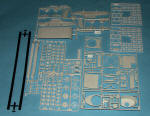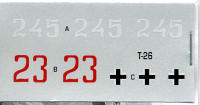
Mirage 1/35 T-26 wz 37
| KIT: | Mirage 1/35 T-26 wz 37 |
| KIT #: | 35308 |
| PRICE: | $15.00 plus tax is what I paid |
| DECALS: | Two or three options |
| REVIEWER: | Scott Van Aken |
| NOTES: |

| HISTORY |
The T-26 was a light tank used by the Soviet Union from the 1930s until World War II. It was based on the British Vickers 6-Ton tank and widely considered one of the most successful designs of the 1930s.
The T-26 made-up the majority of the Red Army's armour force until late 1941, and saw a long history in the armed forces of various different nations around the world. For almost a decade the T-26 proved to be one of the best tanks in production, with a total of around 12,000 units produced. Success and failure in the Spanish Civil War, where it served as the most widely used tank, ultimately played a major role in influencing the Soviet doctrine of tank warfare in the late 1930s; later in its service the T-26's obsolescence contributed to some of the major Soviet defeats during the German invasion of the Soviet Union in 1941.
Although the T-26's reputation was marred by its abysmal performance during World War II, it was nevertheless the most important tank of the Spanish Civil War and played major roles during the Winter War and the Battle of Khalkhin Gol in 1939. Between its introduction and its retirement, the T-26 saw a great deal of modernization efforts between 1932 and 1941.
Many T-26s were captured by the Germans during the initial offensive. Most of the captured tanks were captured without serious damage, a testament to existent mechanical problems within the tank. Under German usage the T-26 was found to have severe clutch problems, a hot steering apparatus and seized bearings. Several T-26Bs were used by the German 3rd SS Panzer Division "Totenkopf" as renamed Mistbiene tanks, or 'droneflies'. The T-26B, redesignated as the T-26B 738(r.) was used extensively by the German Army. Many T-26Cs were also used on the Eastern Front during the war by the Germans. Later in the war, several T-26s of all versions were abandoned by their new German owners due to the same severe mechanical defects which had caused their original capture. Many light tanks were used as tractors to carry Pak guns and artillery guns, and there were also instances where German T-26s were used to support infantry operations as well—these vehicles were renamed the T-26 C740(r).
| THE KIT |
 This Mirage kit of the Russian T-26 is very much an 'old school' tank kit. All the sprues save the track are in white plastic. The molding is quite good with only a trace of flash on a few parts. One side of most large pieces is covered with ejector pin marks, but these should be invisible once the kit is finished.
This Mirage kit of the Russian T-26 is very much an 'old school' tank kit. All the sprues save the track are in white plastic. The molding is quite good with only a trace of flash on a few parts. One side of most large pieces is covered with ejector pin marks, but these should be invisible once the kit is finished.
The hull is made of several sections that are cemented together, unlike modern one-piece lower hull assemblies. There is no interior and much of the construction is spent getting the suspension and tracks in place. There are oodles of road wheels and return rollers on this tank. The track is the old fashioned one piece type made of vinyl and I doubt if it will hold paint as well as the modern Dragon single piece tracks.
The turret is a single piece with a separate forward gun mantlet. Since the T-26 was fitted with a number of different weapons, this makes sense from a kit design point of view. This one is using a 37mm gun. The forward turret section glues onto the front of the turret. There is no opening in the t urret so one does not get a full gun; only the barrel. This does not encourage having open hatches. The body of the tank has the usual number of attachment points for tools and cases. The fenders are a single piece that glues to the side of the body.
urret so one does not get a full gun; only the barrel. This does not encourage having open hatches. The body of the tank has the usual number of attachment points for tools and cases. The fenders are a single piece that glues to the side of the body.
Instructions are well drawn and show all the assembly procedures without any problem. No color information is provided at all and one is left to depend on box profiles. I've still not been able to determine if the road wheels and rollers are actually rubber faced or not, despite whit it shows on the box art. The small decal sheet carries some German crosses and two sets of numbers. The decals are quite matte and have relatively large clear carriers around each one.
| CONCLUSIONS |
Like many of you, I have a fondness for the less usual. When it comes to military vehicles, I prefer wheeled vehicles, artillery and light tanks (of which this qualifies). I also like that I didn't pay a lot for it. I'm sure the build will provide a challenge now and then, but it shouldn't be too horrendous.
| REFERENCES |
Bought by me so you could see what it's like.
April 2008 If you would like your product reviewed fairly and fairly quickly, please contact the editor or see other details in the Note to Contributors.